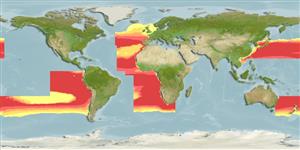分类 / Names
俗名 | 同种异名 | Catalog of Fishes(属, 种) | ITIS | CoL | WoRMS | Cloffa
Teleostei >
Lophiiformes (Anglerfishes) >
Gigantactinidae (Whipnose anglers)
Etymology: Gigantactis: Greek, 'gigas' or 'gigantos' = gigantic + Greek, 'aktis' = ray (referring to the unusually long first dorsal-fin spine that functions as a lure in this genus) (Ref. 86949).
Eponymy: Kai L Elsman was a scientific illustrator, particularly of ichthyological and entomological subjects. The etymology says: “This species is named for the late Kai L. Elsman, whose superb illustrations have added immeasurably to this revision.” (Ref. 128868), visit book page.
Environment: milieu / climate zone / depth range / distribution range
生态学
海洋 深海区的; 深度上下限 0 - 3000 m (Ref. 50610). 深水域
Atlantic Ocean and Pacific Ocean.
東大西洋: 已知來自一個記錄了。 東南太平洋: 已知來自一個記錄了。 西北太平洋: 日本.(參考文獻 559)
大小 / 重量 / 年龄
Maturity: Lm ? range ? - ? cm
Max length : 43.5 cm SL (female)
简单描述
检索表 | 型态特徵 | 形态测量图
背的软条 (总数) : 5; 臀鳍软条: 4 - 5. Metamorphosed females distinguished by the following characteristics: have single proximal lateral pair and two distal pairs of large escal filaments and lacking distinct distal prolongation of the escal bulb; length of illicium less than 130% SL (93-126%SL); absence of escal papillae; relatively short dentary teeth (longest 3.3% DL), arranged in five or six longitudinal series; longest caudal fin rays 21-32.5% SL (Ref. 86949).
Life cycle and mating behavior
成熟度 | 繁殖 | 产卵场 | 卵 | 孕卵数 | 仔鱼
東大西洋: 已知來自一個記錄了。 東南太平洋: 已知來自一個記錄了。 西北太平洋: 日本.(參考文獻 559)
Masuda, H., K. Amaoka, C. Araga, T. Uyeno and T. Yoshino, 1984. The fishes of the Japanese Archipelago. Vol. 1. Tokai University Press, Tokyo, Japan. 437 p. (text). (Ref. 559)
世界自然保护联盟红皮书 (Ref. 130435: Version 2024-1)
人类利用
渔业: 没有兴趣
工具
特别资料
下载 XML
网络资源
Estimates based on models
Preferred temperature (Ref.
123201): 3.1 - 11.2, mean 6.1 °C (based on 429 cells).
Phylogenetic diversity index (Ref.
82804): PD
50 = 0.5000 [Uniqueness, from 0.5 = low to 2.0 = high].
Bayesian length-weight: a=0.01000 (0.00244 - 0.04107), b=3.04 (2.81 - 3.27), in cm total length, based on all LWR estimates for this body shape (Ref.
93245).
营养阶层 (Ref.
69278): 4.4 ±0.7 se; based on size and trophs of closest relatives
Fishing Vulnerability (Ref.
59153): Moderate vulnerability (41 of 100).
